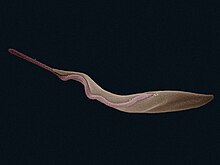Excavata
| Excavata | ||||||
|---|---|---|---|---|---|---|
|
|
||||||
| Systematics | ||||||
|
||||||
| Scientific name | ||||||
| Excavata | ||||||
| Cavalier-Smith , 2002, emend. Simpson, 2003 |
The Excavata are a taxon that is placed as a super-group to the eukaryotes (living beings with a cell nucleus ). They only include unicellular organisms that are invariably flagellated. Within the Euglenozoa there are forms with chloroplasts that photosynthesize accordingly .
features
The name for the unicellular Excavata is the typically shaped cell mouth (cytostome) with a pronounced oral cavity ("excavater" type), which is present in most species. However, this may also have been reduced secondarily. The mouth pit is used by most species to capture food particles and phagocytose them into the cell.
The Euglenozoa have chloroplasts in their parent species and are therefore the only group within the Excavata capable of photosynthesis . The chloroplasts were, however , reduced again in a number of taxa with a parasitic lifestyle.
Systematics

Adl u. a. divide the eukaryotes into three subgroups, the Diaphoretickes , Amorphea and the Excavata. The Excavata are the only ones of the subgroups to contain only one so-called main group . Instead, they are divided into seven groups with no further rankings:
In 2008, independent molecular genetic studies showed that the genus Stephanopogon , which has long been listed as an unsafe position among eukaryotes, is the sister taxon of the genus Percolomonas (still Vahlkampfiidae in Adl ). The clade formed from the two genera in turn is the sister taxon of the Heterolobosea . According to Cavalier-Smith, the two clades together represent the so-called Percolozoa as the sister of the Euglenozoa .
Web links
proof
- ↑ a b c Sina M. Adl, Alastair GB Simpson, Mark A. Farmer, Robert A. Andersen, O. Roger Anderson, John A. Barta, Samual S. Bowser, Guy Bragerolle, Robert A. Fensome, Suzanne Fredericq, Timothy Y. James, Sergei Karpov, Paul Kugrens, John Krug, Christopher E. Lane, Louise A. Lewis, Jean Lodge, Denis H. Lynn, David G. Mann, Richard M. McCourt, Leonel Mendoza, Øjvind Moestrup, Sharon E. Mozley-Standridge, Thomas A. Nerad, Carol A. Shearer, Alexey V. Smirnov, Frederick W. Spiegel, Max FJR Taylor: The New Higher Level Classification of Eukaryotes with Emphasis on the Taxonomy of Protists. The Journal of Eukaryotic Microbiology 52 (5), 2005; Pages 399-451. PMID 16248873 . doi : 10.1111 / j.1550-7408.2005.00053.x .
- ↑ Adl, SM, Simpson, AGB, Lane, CE, Lukeš, J., Bass, D., Bowser, SS, Brown, MW, Burki, F., Dunthorn, M., Hampl, V., Heiss, A. , Hoppenrath, M., Lara, E., le Gall, L., Lynn, DH, McManus, H., Mitchell, EAD, Mozley-Stanridge, SE, Parfrey, LW, Pawlowski, J., Rueckert, S., Shadwick, L., Schoch, CL, Smirnov, A. and Spiegel, FW: The Revised Classification of Eukaryotes. Journal of Eukaryotic Microbiology , 59: 429-514, 2012, PDF Online
- ↑ Naoji Yubuki, Brian S. Leander: Ultrastructure and molecular phylogeny of Stephanopogon minuta: An enigmatic microeukaryote from marine interstitial environments , In: European Journal of Protistology 44, 2008, pp. 241-253
- ↑ Thomas Cavalier-Smith, Sergey Nikolaev: The Zooflagellates Stephanopogon and Percolomonas are a Clade (Class Percolatea: Phylum Percolozoa) In: Journal of Eukaryotic Microbiology, 55 (6), pp. 501-509, 2008